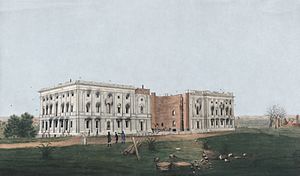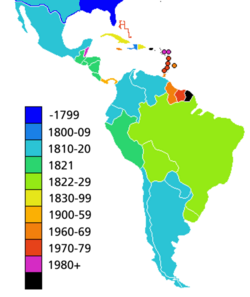History of U.S. foreign policy, 1801–1829 facts for kids
The history of U.S. foreign policy from 1801 to 1829 covers how the United States dealt with other countries during the presidencies of Thomas Jefferson, James Madison, James Monroe, and John Quincy Adams. During this time, the U.S. grew much larger, adding lands like Florida and the huge area between the Mississippi River and the Rocky Mountains.
The early part of this period was heavily influenced by the Napoleonic Wars in Europe. The U.S. got involved in these wars in different ways, leading to the War of 1812. This era began when Thomas Jefferson became president in 1801 and ended when Andrew Jackson became president in 1829.
When President Jefferson took office, he sent people to France to buy the important city of New Orleans. This city was key for trade on the Mississippi River. But the French leader, Napoleon, offered to sell the entire Louisiana territory instead! Jefferson's team accepted, and this deal, called the Louisiana Purchase, doubled the size of the U.S.
Later, during Jefferson's second term, Britain started attacking American ships. This was part of their plan to block trade with France. These attacks continued when James Madison became president. In 1812, the U.S. declared war on Britain, starting the War of 1812. Madison hoped to quickly capture Canada, but the war lasted until 1815 without a clear winner. The Treaty of Ghent ended the war, returning things to how they were before. When Napoleon was finally defeated in 1815, the problem of British and French attacks on American ships ended.
Even though the war with Britain was a draw, the U.S. defeated Native American groups who were allied with Britain. These victories, like the Battle of the Thames and the Battle of Horseshoe Bend, helped the U.S. control the Old Northwest and the Old Southwest. After the war, the U.S. and Britain signed treaties that eased tensions, settled border disagreements, and even shared control of Oregon Country. In 1819, the U.S. and Spain signed the Adams–Onís Treaty, which gave Florida to the United States. Many countries in Latin America also gained independence from Spain during President Monroe's time. In 1823, Monroe announced the Monroe Doctrine. This policy said the U.S. would oppose any future attempts by European powers to colonize the Western Hemisphere.
Contents
U.S. Presidents and Their Teams
Jefferson's Presidency (1801–1809)
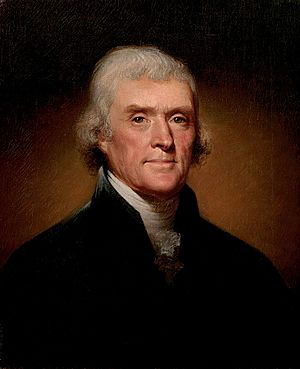
Thomas Jefferson became president in 1801. He chose a strong team to help him. His Secretary of State was James Madison, and his Secretary of the Treasury was Albert Gallatin. Jefferson liked to make decisions with his whole team, and Gallatin and Madison were his most important advisors.
Madison's Presidency (1809–1817)
James Madison became president in 1809. He kept Albert Gallatin as his main advisor. Madison often met with Gallatin alone because he didn't fully trust some other members of his team. Later, James Monroe became Secretary of State and also became a key advisor to Madison.
Monroe's Presidency (1817–1825)
James Monroe won the election in 1816 and became president in 1817. He picked a cabinet with people from different parts of the country. He chose John Quincy Adams from Massachusetts to be his Secretary of State. This was a very important job, and Adams became a major influence in Monroe's government.
Adams's Presidency (1825–1829)
John Quincy Adams became president in 1825. He won a special election in the House of Representatives because no candidate got enough votes in the general election. Adams wanted a balanced team and asked many of Monroe's cabinet members to stay. He chose Henry Clay as his Secretary of State. Adams held weekly meetings with his cabinet to discuss important issues.
The Louisiana Purchase

President Jefferson believed that expanding westward was important for the country. By the time he became president, Americans had settled near the Mississippi River. Many Americans wanted to gain control of the Spanish territory of Louisiana. Jefferson thought it was only a matter of time before either Britain or the U.S. would take it.
However, in 1801, Napoleon convinced Spain to give Louisiana to France. Napoleon dreamed of a new French empire in North America. He planned to control New Orleans and the Caribbean island of Saint-Domingue. But his army in Saint-Domingue was defeated by rebels. This made Napoleon give up his plans for an empire in the Americas.
In early 1803, Jefferson sent James Monroe and Robert Livingston to France. Their goal was to buy New Orleans and parts of Florida. To their surprise, Napoleon offered to sell the entire Louisiana territory for $15 million! The American team quickly agreed to the deal on April 30.
The U.S. Senate quickly approved the purchase. The Louisiana Purchase was completed in December 1803. It ended France's plans in North America and gave the U.S. control of the Mississippi River. This purchase nearly doubled the size of the United States. While most Americans loved the deal, some critics thought the U.S. was spending too much money for land it didn't need.
The Burr Incident
After not being chosen to run with Jefferson in 1804, Aaron Burr lost his election for governor of New York. Later, he was involved in a duel where he killed Alexander Hamilton. Burr was accused of plotting against the U.S. government. Some reports said he wanted to separate the western states or conquer Mexico. President Jefferson was worried about the unity of the country. Burr was arrested and tried for treason, but he was found not guilty. He then left the country.
The War of 1812
Trade Troubles and the Embargo Act
American trade grew a lot after the French Revolutionary Wars began in the 1790s. American ships could trade with many European countries as neutral carriers. But after 1805, relations with Britain got worse. The British Royal Navy started seizing American ships and forcing American sailors to join their navy. This practice, called "impressment," angered Americans greatly.
Britain also began blocking trade with Europe, which hurt American businesses. Americans felt their national honor was being attacked. In response, Jefferson suggested expanding the navy. Congress passed the Non-importation Act, which limited British imports.
To try and make peace, a treaty was negotiated, but Jefferson rejected it. Tensions grew even more after the Chesapeake–Leopard affair in 1807, where a British ship attacked an American ship. France also started seizing American ships that traded with Britain.
To stop these attacks, Congress passed the Embargo Act in 1807. This law stopped all American shipping to Britain or France. The idea was to force them to respect U.S. neutrality. However, Americans started smuggling goods, and Jefferson had to use the military to enforce the embargo. Trade dropped sharply, and the embargo became very unpopular, especially in New England. Most historians agree that the embargo was not effective and hurt American interests.
Leading Up to War
In 1809, Congress passed a new law that allowed trade with all countries except France and Britain. The main problem between Britain and the U.S. was still impressment. Many British sailors were forced into their navy, and some escaped to work on U.S. merchant ships. Britain couldn't stand losing these sailors, so they seized American ships and forced crewmen into their navy, even if they weren't British. Americans were furious, but they also didn't want to stop hiring British sailors for economic reasons.
President Madison tried to get Britain to stop their attacks, but British leaders refused. Madison didn't want war because it would mean more debt and taxes. However, British actions continued to anger Americans.
In 1810, Madison asked Congress for more money to build up the army and navy. Congress passed a law that reopened trade with France and Britain. It also said that if one country stopped attacking American ships, the U.S. would stop trading with the other. Napoleon offered to stop French attacks if the U.S. punished countries that didn't do the same. Madison accepted, hoping Britain would change its policies, but they didn't. France also continued to attack American ships despite their promise.
As attacks on American shipping continued, Madison and the American public were ready for war with Britain. Many Americans felt it was a "second war of independence" to gain respect for the young nation. A group of politicians called "war hawks," led by Henry Clay and John C. Calhoun, pushed for war. Many believed the U.S. could easily capture Canada and use it as a bargaining chip.
On June 1, 1812, Madison asked Congress to declare war. Congress approved, but there was strong opposition from the Northeast, where the economy had suffered from trade restrictions. Before the war, Jefferson and Madison had reduced the military's size and lowered taxes. This meant the U.S. army was mostly made up of poorly trained militia members when the war began.
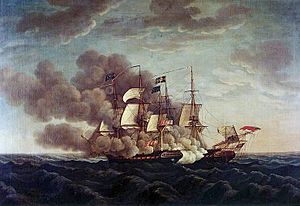
Battles and Outcomes
Madison hoped the war would end quickly with the capture of Canada, but this didn't happen. State militias in the Northeast refused to fight outside their states. American generals were often not very good. It was also hard to pay for the war because the national bank had been closed, and bankers in New England refused to help.
Despite a rough start, the U.S. had some successes, especially at sea. American merchant ships became privateers and captured many British ships. The U.S. Navy also built up its strength. On Lake Erie, the U.S. naval squadron won a key victory, which hurt British forces in the west. After this, General William Henry Harrison defeated British and Native American forces at the Battle of the Thames. The death of the Shawnee chief Tecumseh in this battle ended major Native American resistance in the Old Northwest. In the Old Southwest, General Andrew Jackson defeated the Muscogee (Creek) people at the Battle of Horseshoe Bend in 1814.
However, the British continued to stop American attempts to invade Canada. In 1814, after Napoleon was defeated in Europe, Britain sent more soldiers to North America.
In August 1814, British forces landed near Washington D.C. They defeated American forces at the Battle of Bladensburg and then burned federal buildings in Washington, including the White House. First Lady Dolley Madison famously saved important valuables and documents from the White House. The British then moved to Baltimore but were stopped when the U.S. successfully defended Fort McHenry. The British also tried to invade New York from Canada, but the U.S. victory at the Battle of Plattsburgh in September 1814 ended that plan.
Knowing the British might attack New Orleans next, Secretary of War James Monroe ordered General Jackson to prepare the city's defense. On January 8, 1815, Jackson's forces famously defeated the British at the Battle of New Orleans. Just over a month later, Madison learned that a peace treaty, the Treaty of Ghent, had been signed. This treaty ended the war with no major changes for either side.
To most Americans, it seemed like the victory at New Orleans forced the British to surrender, even though the treaty was signed before the battle. This idea led to great excitement and pride in the U.S. Madison's reputation improved, and Americans felt the United States had truly become a world power.
After the War
After his victory at Horseshoe Bend, General Jackson forced the Muscogee and Cherokee to give up 22 million acres of land in Alabama and Georgia. The British abandoned their Native American allies, and the U.S. gained firm control of its western frontiers.
During Monroe's presidency, the U.S. and Britain signed two important agreements. The Rush–Bagot Treaty (1817) limited naval weapons on the Great Lakes, making the border with Canada more peaceful. The Treaty of 1818 set the border between the U.S. and Canada from Minnesota to the Rocky Mountains. It also allowed the U.S. and Britain to share control of Oregon Country for ten years. These treaties helped improve relations between the U.S. and Britain.
Barbary Wars
First Barbary War
For many years, pirates from the Barbary Coast in North Africa had been capturing American merchant ships. They would steal goods and enslave crew members, demanding large payments for their release. Before the U.S. became independent, British ships protected American trade. But after independence, that protection ended. In 1794, Congress allowed payments to these Barbary States to stop the attacks. They also started building six frigates, which became the beginning of the United States Navy.
Just before Jefferson became president, Tripoli started attacking American ships again, demanding more money. Jefferson didn't want conflict, but he believed force was the best way to stop them. He sent the U.S. Navy to the Mediterranean Sea, starting the First Barbary War.
At first, the U.S. efforts weren't very successful. In 1803, the ship USS Philadelphia was captured by Tripoli. But in 1804, Lieutenant Stephen Decatur led a daring raid that burned the Philadelphia, making him a national hero. Jefferson and the young American navy forced Tunis and Algiers to break their alliance with Tripoli. Jefferson also ordered several naval attacks on Tripoli. This brought peace to the Mediterranean for a while, though the U.S. continued to pay some Barbary States until the end of his presidency.
Second Barbary War
During the War of 1812, the Barbary States increased their attacks on American shipping. These states, though part of the Ottoman Empire, acted independently. They demanded payments from countries that traded in the Mediterranean Sea. After the War of 1812 ended, the U.S. could use its now larger navy against them.
Congress declared war on Algiers in March 1815, starting the Second Barbary War. The U.S. sent seventeen ships, the largest fleet it had ever assembled, to the Mediterranean. After several defeats, Algiers agreed to a treaty. Tunis and Tripoli also signed treaties. The Barbary States agreed to release all prisoners and stop demanding payments.
Spanish Florida
The Seminole Wars
Spain had very few soldiers in Florida, so they couldn't control the Seminole Native Americans. The Seminoles often raided American villages and farms across the border in Georgia. They also offered safety to enslaved people who had escaped from the U.S. To stop these raids and protect runaway slaves, the U.S. Army began entering Spanish territory more often.
In 1818, President Monroe ordered General Andrew Jackson to the Georgia-Florida border. Jackson was told to attack Seminole camps in Spanish Florida, but not Spanish settlements. However, in what became known as the First Seminole War, Jackson crossed into Spanish territory and attacked a Spanish fort called St. Marks. He also executed two British citizens, claiming they had encouraged the Seminoles to raid American settlements. Jackson said he had to attack the fort because the Spanish were helping the Seminoles. After taking St. Marks, Jackson captured Pensacola, another Spanish position, in May 1818.
Monroe told Jackson he had gone too far, but he also knew Jackson's actions made the U.S. stronger in talks with Spain about buying Florida. Jackson's campaign showed that Spain couldn't defend its own territories. The Monroe administration gave Florida back to Spain but asked them to do more to stop Seminole raids. Secretary of State Adams argued that Jackson's actions were justified because Spain couldn't control its own land. His arguments helped convince Britain and Spain not to retaliate against the U.S. for Jackson's behavior.
Jackson's actions caused a lot of debate in Washington. Some in Congress worried about a general making war without Congress's approval. However, Congress generally supported expansion and the popular Jackson. After much discussion, the House of Representatives voted against condemning Jackson, which meant they basically approved his military actions.
Buying Florida

Talks to buy Florida began in early 1818. Spain's representative, Don Luis de Onís, stopped talks after Jackson attacked Spanish settlements. But he restarted them with Secretary of State Adams after the U.S. returned the territories. On February 22, 1819, Spain and the United States signed the Adams–Onís Treaty. This treaty gave Florida to the U.S. The U.S. also agreed to pay up to $5 million to American citizens who had claims against Spain. This money wasn't a purchase price for the land itself.
The treaty also drew a clear border between Spanish and American lands in North America. The U.S. gave up its claims to lands west and south of this new border, while Spain gave up its claim to Oregon Country. Spain took some time to give up control of Florida, which made some in Congress want war. But Spain peacefully transferred control in February 1821.
Latin America
New Independent Nations
President Monroe strongly supported the Latin American countries fighting for independence from Spain. He wanted the U.S. to show sympathy for these new republics, unlike how it acted during the French Revolution. He didn't want to get involved militarily, only to offer moral support. He believed direct U.S. involvement might make European powers help Spain. At first, Monroe didn't officially recognize these new governments because of ongoing talks with Spain about Florida.
In March 1822, Monroe officially recognized the new countries of Argentina, Peru, Colombia, Chile, and Mexico. Secretary of State Adams wrote instructions for the U.S. ambassadors to these nations. They said the U.S. would support republican governments and seek fair trade agreements. Monroe was proud that the U.S. was the first nation to recognize these new countries. In 1824, the U.S. signed its first treaty with another country in the Americas, Gran Colombia. The number of U.S. consuls (officials who help citizens and promote trade) in foreign countries doubled between 1820 and 1830, mostly in Latin America. These consuls helped expand U.S. trade in the Western Hemisphere.
The Monroe Doctrine
Britain also wanted to see Spanish colonies become independent. Spain had a policy that limited trade between its colonies and other countries. In 1823, Britain suggested a joint statement with the U.S. to stop other European powers from interfering in Central and South America. Britain worried that France or other European countries might help Spain regain control of its colonies.
Monroe and Adams discussed Britain's idea. Monroe was at first open to it, and former presidents Jefferson and Madison agreed. However, Adams strongly opposed working with Britain. He argued that a joint statement might limit future U.S. expansion. Also, Adams and Monroe didn't want the U.S. to seem like a junior partner in any alliance.
Instead of joining Britain, Monroe decided to make a statement about Latin America in his yearly message to Congress on December 2, 1823. In this message, he announced what became known as the Monroe Doctrine. The doctrine repeated the traditional U.S. policy of staying neutral in European wars. But it also declared that the U.S. would not accept any European country trying to recolonize any independent nation in the Western Hemisphere. Monroe said that European countries should no longer try to colonize the Americas. At the same time, he said the U.S. would not interfere with existing European colonies.
The Monroe Doctrine was popular in the U.S. and Britain. Other European leaders didn't like it. They knew the U.S. didn't have a strong military to enforce it. However, the U.S. benefited from the strength of the British Royal Navy, which also wanted to keep European powers out of the Americas. The Monroe Doctrine showed that the U.S. was becoming more confident in international relations. It also marked a shift in the country's focus from Europe to the Americas.
Adams and Latin America
President Adams and Secretary of State Clay wanted to work with Latin American countries. They hoped to prevent Britain from gaining too much economic influence there. Adams wanted to send a U.S. team to the Congress of Panama in 1826, a meeting of new American republics organized by Simón Bolívar. Adams and Clay hoped this meeting would start a "Good Neighborhood Policy" among the independent American states. However, political disagreements in the U.S. Congress delayed the approval of the delegation. Even though the team was finally approved, they never reached the Congress of Panama because of the delays.
In 1825, the ambassador from the Federal Republic of Central America suggested building a canal across Nicaragua. Adams was interested in the idea, but the project failed due to lack of money.
After Mexico gained independence, the Adams administration tried to buy Texas from them, but they were unsuccessful. In 1826, American settlers in Texas started a rebellion, but Adams prevented the U.S. from getting directly involved.
Trade and Claims
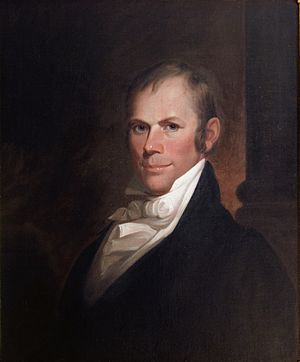
One of President Adams's main foreign policy goals was to expand American trade. His administration signed trade agreements with many countries, including Denmark, Prussia, and the Federal Republic of Central America. They also made commercial deals with the Kingdom of Hawaii and the Kingdom of Tahiti. Adams also renewed existing treaties with Britain, France, and the Netherlands. These treaties aimed to increase trade during peacetime and protect American trading rights during wars.
Adams especially wanted to restart trade with the West Indies, which had dropped a lot since 1801. Agreements with Denmark and Sweden opened their colonies to American trade. But Adams focused on opening trade with the British West Indies. Britain had allowed some American imports there since 1823, but the U.S. wanted to end Britain's protective trade system. In 1825, Britain banned U.S. trade with the British West Indies, which hurt Adams's efforts. Despite this, the other trade agreements Adams secured helped increase the overall amount of U.S. exports.
The Adams administration also settled several old American claims for damages from the Napoleonic Wars and the War of 1812. The U.S. received about $1 million from Britain and smaller amounts from Sweden, Denmark, and Russia. However, the U.S. was not successful in getting a large payment from France or from Mexico.
Other Important Events
Haiti
After 1802, when Jefferson learned that Napoleon wanted to regain control of Saint-Domingue (Haiti), Jefferson declared that the U.S. would be neutral in the Haitian Revolution. The U.S. allowed trade goods to reach the Haitian rebels but refused French requests for help or loans. After the rebels in Saint-Domingue declared independence and formed the new republic of Haiti in 1804, Jefferson refused to recognize Haiti. This was partly because he hoped to gain Napoleon's support for buying Florida. Also, many slaveholders in the Southern U.S. were scared by the slave rebellion in Haiti and worried it might encourage similar revolts in the American South.
Ending the Slave Trade
In the 1790s, many people believed that slavery would eventually end in the U.S. The U.S. Constitution had a rule that prevented Congress from banning the international slave trade until 1808. As the fear of slave rebellions grew in the South, enthusiasm for ending slavery there decreased.
However, seeing that the 1808 deadline was approaching, President Jefferson called for a law to ban the international slave trade in December 1806. He spoke out against the trade as a violation of human rights. Jefferson signed the new law, and the international slave trade became illegal in January 1808. Britain also made the international trade illegal at the same time. Before this, about 14,000 enslaved people were brought into the U.S. each year. After the ban, illegal smuggling continued, but at a much lower rate. Historians consider the Louisiana Purchase and the end of the international slave trade to be two major achievements of Jefferson's presidency.
Treaty with Russia
In the 1700s, Russia had established colonies on the Pacific coast of North America, known as Russian America. In 1821, the Russian Tsar declared Russia's control over the Pacific coast north of a certain line. This declaration also said that foreign ships could not come within 115 miles of Russian claims. Secretary of State Adams strongly protested this, as it could hurt U.S. trade and expansion plans. Wanting good relations with the U.S., Russia agreed to the Russo-American Treaty of 1824. In this treaty, Russia limited its claims to lands north of a higher parallel and agreed to open its ports to U.S. ships.



